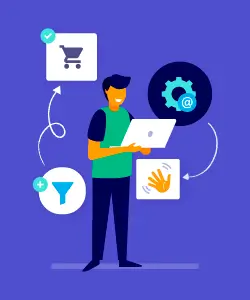The Top 5 Strategies Busy Marketers Should Prioritize for Maximum Impact
May 8, 2024 4 min read

Time is limited, which is why it’s essential for busy marketers to focus their efforts on strategies that deliver maximum impact. With countless tasks vying for attention, knowing where to allocate time and resources can be challenging.
To help organize and simplify your efforts and achieve better results, we’ve compiled a list of the top five strategies that busy marketers should prioritize.
1. Audience Segmentation and Personalization
You can no longer get by with a one-size-fits-all marketing approach. Most consumers don’t just enjoy personalization, they expect to receive content tailored to their specific needs and preferences. That’s why audience segmentation and personalization should be at the top of every busy marketer’s priority list.
Start by dividing your audience into distinct segments based on demographics, behaviors, interests, and other relevant factors. This is the first step in creating targeted campaigns that resonate with each segment, which will increase engagement and drive conversions.
Utilize data from your CRM system, email marketing platform, and other sources to gather insights about your audience and deliver personalized content at every touchpoint. Whether it’s personalized email campaigns, dynamic content, or targeted social media ads, personalization is key to building trust and a strong connection with your audience.
2. Content Marketing
Content is at the core of any successful marketing strategy. It’s what attracts, engages, and converts prospects into customers. That’s why busy marketers should prioritize content marketing as a core component of their strategy.
Invest time and resources into creating high-quality, relevant content that educates, entertains, and adds value to your audience. Whether it’s blog posts, videos, infographics, or podcasts, diversifying your content formats will help you appeal to different preferences and consumption habits.
It’s critical that the content you create addresses your audience’s specific pain points, solves their problems, and answers their questions. Use keyword research and SEO tactics to guarantee your content is findable online and ranks high in search engines.
Additionally, leverage your content across multiple channels and touchpoints to maximize its reach and impact. Promote your blog posts on social media, repurpose content into email newsletters, and collaborate with influencers to amplify your message.
3. Data-Driven Decision Making
In today’s data-driven world, marketers have access to a wealth of information about their audience, campaigns, and performance metrics. By harnessing the power of data, you’ll be able to make more informed decisions in less time and optimize your approach so it yields better results.
To start, identify key performance indicators (KPIs), and make sure they align with your overall business goals, such as conversion rate, ROI, customer acquisition cost, and lifetime value. Use analytics tools to track and measure these KPIs across your marketing channels and campaigns.
Consistently analyze your data to identify trends, patterns, and areas for improvement. Look for insights that can inform your strategy and help you make data-driven decisions. For example, if you notice a particular email campaign performing well with a certain audience segment, you can replicate that success in future campaigns.
Experiment with A/B testing to test different variables, such as subject lines, CTAs, and ad copy, and use the results to optimize your campaigns for maximum impact. By leveraging data-driven insights, busy marketers can continuously refine their strategies and drive better results over time.
4. Marketing Automation
As a busy marketer, time is your most valuable resource. That’s why marketing automation should be a top priority for streamlining your workflow and increasing efficiency.
Invest in marketing automation tools that allow you to automate repetitive tasks, such as email campaigns, social media posts, lead nurturing, and customer follow-ups. Set up automated workflows that deploy based on various actions, like user behavior, website visits, or form submissions.
With these automated processes, you can save time and resources while delivering timely, personalized experiences to your audience. This affords you the time to focus on higher-value tasks, such as strategy development, content creation, and campaign optimization.
Additionally, marketing automation can be used to nurture leads through the sales funnel and drive conversions. Set up automated email drip campaigns that deliver relevant content to prospects at each stage of their buyer’s journey, helping to move them closer to making a purchase.

5. Social Media Engagement
Social media has become an integral part of the marketing landscape, providing marketers with a powerful avenue to connect with their audience, build brand awareness, and drive engagement. That’s why busy marketers should prioritize social media engagement as a key strategy for reaching their target audience and fostering meaningful relationships.
Start by identifying the social media channels your audience is on regularly. Focuson building a strong presence on these platforms, sharing valuable content, engaging with followers, and participating in conversations.
Develop a social media content calendar to plan and schedule your social media posts in advance. This will ensure a consistent presence and maintain engagement with your audience. Experiment with different types of content, such as images, videos, and polls to keep your feed fresh and engaging.
Monitor social media conversations and mentions of your brand to stay informed about what people are saying and to address any issues or concerns in a timely manner. Use social listening tools to track keywords, hashtags, and trends related to your industry, allowing you to identify opportunities for engagement and capitalize on them.
Busy marketers can achieve maximum impact by prioritizing these five key strategies: audience segmentation and personalization, content marketing, data-driven decision-making, marketing automation, and social media engagement. By focusing their efforts on these areas, marketers can streamline their workflow, increase efficiency, and drive better business results.







